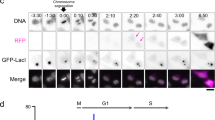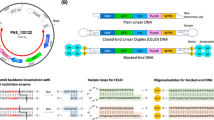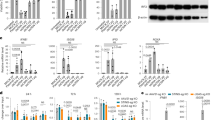Abstract
Inefficient nuclear delivery of plasmid DNA is thought to be one of the daunting hurdles to gene transfer, utilizing a nonviral delivery system such as polycation–DNA complex. Following its internalization by endocytosis, plasmid DNA has to be released into the cytosol before its nuclear entry can occur. However, the stability of plasmid DNA in the cytoplasm, that may play a determinant role in the transfection efficiency, is not known. The turnover of plasmid DNA, delivered by microinjection into the cytosol, was determined by fluorescence in situ hybridization (FISH) and quantitative single-cell fluorescence video-image analysis. Both single- and double-stranded circular plasmid DNA disappeared with an apparent half-life of 50–90 min from the cytoplasm of HeLa and COS cells, while the amount of co-injected dextran (MW 70000) remained unaltered. We propose that cytosolic nuclease(s) are responsible for the rapid degradation of plasmid DNA, since (1) elimination of plasmid DNA cannot be attributed to cell division or to the activity of apoptotic and lysosomal nucleases; (2) disposal of microinjected plasmid DNA was inhibited in cytosol-depleted cells or following the encapsulation of DNA in phospholipid vesicles; (3) generation and subsequent elimination of free 3′-OH ends could be detected by the terminal deoxynucleotidyl transferase-mediated dUTP nick end-labeling assay (TUNEL), reflecting the fragmentation of the injected DNA; and finally (4) isolated cytosol, obtained by selective permeabilization of the plasma membrane, exhibits divalent cation-dependent, thermolabile nuclease activity, determined by Southern blotting and 32P-release from end-labeled DNA. Collectively, these findings suggest that the metabolic instability of plasmid DNA, caused by cytosolic nuclease, may constitute a previously unrecognized impediment for DNA translocation into the nucleus and a possible target to enhance the efficiency of gene delivery.
This is a preview of subscription content, access via your institution
Access options
Subscribe to this journal
Receive 12 print issues and online access
$259.00 per year
only $21.58 per issue
Buy this article
- Purchase on Springer Link
- Instant access to full article PDF
Prices may be subject to local taxes which are calculated during checkout







Similar content being viewed by others
References
Zabner J et al. Cellular and molecular barriers to gene transfer by a cationic lipid J Biol Chem 1995 270: 18997–19007
Fasbender A et al. Complexes of adenovirus with polycationic polymers and cationic lipids increase the efficiency of gene transfer in vitro and in vivo J Biol Chem 1997 272: 6479–6489
Chowdhury NR et al. Microtubular disruption prolongs the expression of human bilirubin-uridinediphosphoglucuronate-glucuronyltransferase-1 gene transferred into Gunn rat livers J Biol Chem 1996 271: 2341–2346
Coonrod A, Li F-Q, Horwitz M . On the mechanism of DNA transfection: efficient gene transfer without viruses Gene Therapy 1997 4: 1313–1321
Dowty M, Williams P, Zhang G, Wolff J . Plasmid DNA entry into post-mitotic nuclei of primary rat myotubes Proc Natl Acad Sci USA 1995 92: 4572–4576
Farhood H, Serbina N, Huang L . The role of dioleoyl phosphatidylethanolamine in cationic liposome mediated gene transfer Biochim Biophys Acta 1995 1235: 289–295
Zelphati O, Szoka FC . Mechanism of oligonucleotide release from cationic liposomes Proc Natl Acad Sci USA 1996 93: 11493–11498
Zelphati O, Szoka FC . Intracellular distribution and mechanism of delivery of oligonucleotides mediated by cationic lipids Pharm Res 1996 13: 1367–1372
Gao X, Huang L . Cytoplasmic expression of a reporter gene by co-delivery of T7 RNNA polymerase and T7 promoter sequence with cationic liposomes Nucleic Acids Res 1993 21: 2867–2872
Fasbender A et al. Effect of co-lipids in enhancing cationic lipid-mediated gene transfer in vitro and in vivo Gene Therapy 1997 4: 716–725
Collas P, Alestrom P . Nuclear localization signal of SV40 T antigen directs import of plasmid DNA into sea urchin male pronuclei in vitro Mol Reprod Develop 1996 45: 431–438
Fasbender A, Zabner J, Zeiher BG, Welsh MJ . A low rate of cell proliferation and reduced DNA limit cationic lipid-mediated gene transfer to primary cultures of ciliated human airway epithelia Gene Therapy 1997 4: 1173–1180
Wilke M et al. Efficacy of a peptide-based gene delivery system depends on mitotic activity Gene Theapy 1996 3: 1133–1142
Sebestyen MG eta l . DNA vector chemistry: the covalent attachment of signal peptides to plasmid DNA Nature Biotechnol 1998 16: 80–85
Dunn WA . Autophagy and related mechanisms of lysosome-mediated protein degradation Trends Cell Biol 1994 4: 139–143
Hagstrom JE et al. Nuclear import of DNA in digitonin-permeabilized cells J Cell Sci 1997 110: 2323–2331
Liao T-H, Liao W-C, Chang H-C, Lu K-S . Deoxyribonuclease II purified from the isolated lysosomes of porcine spleen and from porcine liver homogenates. Comparison with deoxyribonuclease II purified from porcine spleen homogenates Biochim Biophys Acta 1989 1007: 15–22
Luthman H, Magnusson G . High efficiency polyoma DNA transfection of chloroquine treated cells Nucleic Acids Res 1983 11: 1295–1308
Helenius A, Marsh M, White J . Inhibition of Semliki forest virus penetration by lysomotropic weak bases J Gen Virol 1982 58: 47–61.
Lukacs GL et al. Conformational maturation of CFTR but not its mutant counterpart (ΔF508) occurs in the endoplasmic reticulum and requires ATP EMBO J 1994 13: 6076–6086
Adam SA, Sterne Marr R, Gerace L . Nuclear import in permeabilized cells requires soluble cytoplasmic factors J Cell Biol 1990 111: 807–816
Bittner MA, Holz RW . Effect of tetanus toxin on catecholamine release from intact and digitonin permeabilized chromaffin cells J Neurochem 1988 51: 451–456
Cappaccioli S et al. Cationic lipids improve antisense oligonucleotide uptake and prevent degradation in cultured cells and in human serum Biochem Biophys Res Com 1993 197: 818–825
Chiou HC et al. Enhanced resistance to nuclease degradation of nucleic acids complexed to asialoglycoprotein–polylysine carriers Nucleic Acids Res 1994 22: 5439–5446
Wheeler JJ et al. Stabilized plasmid-lipid particles: construction and characterization Gene Therapy 1999 (in press)
Tanswell AK et al. Liposome-mediated transfection of fetal lung epithelial cells: DNA degradation and enhanced superoxide toxicity Am J Physiol 1998 275: L452–L460
Chen JW et al. Identification of two lysosomal membrane glycoproteins J Cell Biol 1985 101: 85–95
Miyake K, McNeil PL . Vesicle accumulation and exocytosis at sites of plasma membrane disruption J Cell Biol 1995 131: 1737–1745
Steinhardt RA, Bi G, Alderton JM . Cell membrane resealing by a vesicular mechanism similar to neurotransmitter release Science 1994 263: 390–393
Polzar B et al. Overexpression of deoxyribuonuclease I (DNase I) transfected into COS-cells: its distribution during apoptotic cell death Eur J Cell Biol 1993 62: 397–405
Polzar B et al. Distribution of DNase I in rat tissues and its correlation to cellular turnover and apoptosis (programmed cell death) Eur J Cell Biol 1994 64: 200–210
Peitsch MC, Mannherz HG, Tschopp J . The apoptotic endonucleases: cleaning up after cell death? Trends Cell Biol 1994 4: 37–41
Collins MKL et al. An apoptotic endonuclease activated either by decreasing the pH or by increasing calcium J Cell Sci 1996 109: 2393–2399
Kataoka A et al. Association of high molecular weight DNA fragmentation with apoptotic or non-apoptotic cell death induced by calcium ionophore FEBS Lett 1995 364: 264–267
Villalba M et al. Ionic regulation of endonuclease activity in PC12 cells Biochem J 1995 311: 1033–1038
Sakahira H, Enari M, Nagata S . Cleavage of CAD inhibitor in CAD activation and DNA degradation during apoptosis Nature 1998 391: 96–99
Enari M et al. A caspase-activated DNase that degrades DNA during apoptosis, and its inhibitor ICAD Nature 1998 391: 43–50.
Lazarovici P et al. Affinity purified tetanus toxin binds to isolated chromaffin granules and inhibits catecholamine release in digitonin-permeabilized chromaffin cells FEBS Lett 1989 253: 121–128
Batistatou A, Green LA . Internucleosomal DNA cleavage and neuronal cell death/survival J Cell Biol 1993 122: 523–532
Benchokroun Y, Couprie J, Larsen AK . Aurintricarboxilic acid, a putative inhibitor of apoptosis, is a potent inhibitor of DNA topoisomerase II in vitro and in Chinese hamster fibrosarcoma cells Biochem Pharmacol 1995 49: 305–313
Wittels M, Spear PG . Penetration of cells by herpes simplex virus does not require a low pH-dependent endocytic pathway Virus Res 1991 18: 271–290
Greber UF, Willetts M, Webster P, Helenius A . Stepwise dismantling of adenovirus 2 during entry into cells Cell 1993 75: 477–486
Greber UF, Singh I, Helenius A . Mechanism of virus uncoating Trends Microbiol 1994 2: 52–56
Zauner W . Glycerol and polylysine synergise in their ability to rupture vesicular membranes: a mechanism for increase transferrin–polylysine-mediated gene transfer Exp Cell Res 1997 232: 137–145
Plank C et al. The influence of endosome-disruptive peptides on gene transfer using synthetic virus-like gene transfer systems J Biol Chem 1994 269: 12918–12924
Nakanishi A et al. Association with capsid protein promotes nuclear targeting of simian virus 40 DNA Proc Natl Acad Sci USA 1996 93: 96–100
Kann M, Bischof A, Gerlich WH . In vitro model for the nuclear transport of the hepadnavirus genome J Virol 1997 71: 1310–1316
Lechardeur D et al. The cytosol constitutes a metabolic barrier against transgene delivery to the nucleus Ped Pulm 1997 S14: 255
Capecchi MR . High efficiency transformation by direct microinjection of DNA into cultured mammalian cells Cell 1980 22: 479–488
Luby-Phelps K, Castle PE, Taylor DL, Lanni F . Hindered diffusion of inert tracer particles in the cytoplasm of mouse 3T3 cells Proc Natl Acad Sci USA 1987 84: 4910–4913
Luby-Phelps K . Physical properties of cytoplasm Curr Opin Cell Biol 1994 6: 3–9
Seksek O, Biwersi J, Verkman AS . Translational diffusion of macromolecule-sized solutes in cytoplasm and nucleus J Cell Biol 1997 138: 131–142
Pollard H et al. Polyethylenimine but not the cationic lipids promotes transgene delivery to the nucleus in mammalian cells J Biol Chem 1998 273: 7507–7511
Vanderbilt JN, Bloom KS, Anderson JN . Endogenous nucleases J Biol Chem 1982 257: 13009–13017
Cummings OW, King TC, Holden JA, Low RL . Purification and characterization of a potent endonuclease in extracts of bovine heart mitochondria J Biol Chem 1987 262: 2005–2015
Wyllie AH . Glucocorticoid-induced thymocyte apoptosis is associated with endogenous endonuclease activity Nature 1980 284: 555–556
Torriglia A et al. Involvement of DNase II in nuclear degeneration during lens cell differentiation J Biol Chem 1995 270: 28579–28585
Rauch F et al. Androgen ablation leads to an upregulation and intranuclear accumulation of DNase I in rat prostate epithelial cells paralleling their apoptotic elimination J Cell Biol 1997 137: 909–923
Barry MA, Eastman A . Identification of deoxyribonuclease II as an endonuclease involved in apoptosis Arch Biochem Biophys 1993 300: 440–450
Montague JW, Hughes FM, Cidlowski JA . Native recombinant cyclophilins A, B, and C degrade DNA independently of peptidylprolyl cis-trans-isomerase activity J Cell Biol 1997 272: 6677–6684
Sodeik B, Ebersold MW, Helenius A . Microtubule-mediated transport of incoming herpes simplex virus 1 capsids to the nucleus J Cell Biol 1997 136: 1007–1021
Radloff R, Bauer W, Vinograd J . A dye-buoyant-density method for the detection and isolation of closed circular duplex DNA: the closed circular DNA in HeLa cells Proc Natl Acad Sci USA 1967 57: 1514–1521
Vieira J, Messing J . Production of single-stranded plasmid DNA Meth Enzymol 1987 153: 3–11
Trask BJ . DNA localization in metaphase and interphase cells by fluorescence in situ hybridization Meth Cell Biol 1991 35: 3–35
Hofer AM, Machen TE . Technique for in situ measurements of calcium in intracellular inositol 1,4,5-trisphosphate-sensitive stores using the fluorescent indicator mag-fura-2 Proc Natl Acad Sci USA 1993 90: 2598–2602
McGraw TE, Pytowski B, Arzt J, Ferrone C . Mutagenesis of the human transferrin receptor: two cytoplasmic phenylalanines are required for efficient internalization and a second-site mutation is capable of reverting an internalization-defective phenotype J Cell Biol 1991 112: 853–861
Storrie B, Madden EA . Isolation of subcellular organelles Meth Enzymol 1990 182: 203–227
Author information
Authors and Affiliations
Rights and permissions
About this article
Cite this article
Lechardeur, D., Sohn, KJ., Haardt, M. et al. Metabolic instability of plasmid DNA in the cytosol: a potential barrier to gene transfer. Gene Ther 6, 482–497 (1999). https://doi.org/10.1038/sj.gt.3300867
Received:
Accepted:
Published:
Issue Date:
DOI: https://doi.org/10.1038/sj.gt.3300867
Keywords
This article is cited by
-
Selective attachment of a microtubule interacting peptide to plasmid DNA via a triplex forming oligonucleotide for transfection improvement
Gene Therapy (2023)
-
A cationic lipid mediated CRISPR/Cas9 technique for the production of stable genome edited citrus plants
Plant Methods (2022)
-
Laser-based molecular delivery and its applications in plant science
Plant Methods (2022)
-
Ultrasonic microbubble VEGF gene delivery improves angiogenesis of senescent endothelial progenitor cells
Scientific Reports (2021)
-
Targeting the Inside of Cells with Biologicals: Chemicals as a Delivery Strategy
BioDrugs (2021)



